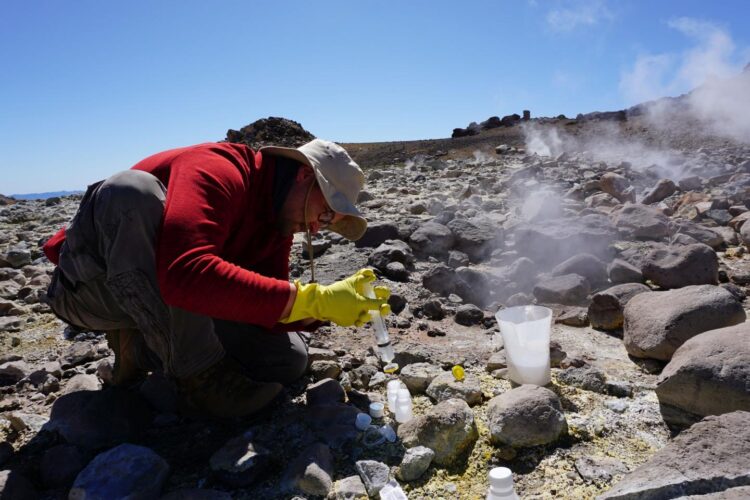Brinemine project at KIT: Responsible extraction of energy, raw materials, and drinking water from geothermal wells
Mineral resources from Chile are of great importance to Germany. According to statistics from the World Bank, thousands of tons of valuable minerals are imported from the South American country every year, including raw materials for lithium-ion batteries. But their extraction causes ecological and social problems: “The use of the limited freshwater resources in northern Chile for mining regularly fuels conflicts with the local population,” says Professor Thomas Kohl from KIT’s Institute of Applied Geosciences (AGW). “Northern Chile is one of the driest regions on earth, but has extensive geothermal resources. With a novel type of plant, it is not only possible to generate electricity in a climate-friendly way, but also to extract drinking water and even mineral resources at the same time.” The AGW team of BrineMine, a German-Chilean research project, is developing the necessary strategies and technologies.
AGW has a long history of cooperation in the field of geothermal research in Chile. Its main partner is the Centro de Excelencia en Geotermia de Los Andes (CEGA). “BrineMine demonstrates how well the cooperation between Chilean and German institutions works,” says Professor Diego Morata, director of CEGA. “Sustainable development, achieved by the combination of geothermal and green mining, can benefit Europe and the Andean region alike.”
First Demonstration Plant on the Upper Rhine Graben
Part of the transdisciplinary research initiative is dedicated to the geochemical and geothermal potential of thermal wells in Chile in order to identify suitable sites. A data survey is being conducted to determine the raw materials potential with a focus on the thermal fields of the Atacama Desert. In addition, the Fraunhofer Institute for Solar Energy Systems (ISE) takes part in the BrineMine project by developing the plant technology for later industrial use. It is based on a novel process chain: First, heat from the geothermal brine is used for energy recovery. The cooled liquid, which has a relatively low concentration, is then pre-concentrated by reverse osmosis; at the same time, drinking water is obtained. The brine concentrate is then further concentrated by membrane distillation until it is saturated. “The thermal energy required for the entire process can be covered directly from the excess heat of the power plant process,” explains project manager Dr. Joachim Koschikowski from ISE. “We have already set up a demonstration plant in a geothermal power plant in the Upper Rhine Graben and successfully integrated key components into ongoing power plant operations.”
Optimization of Processes for Raw Material Mining
Most of the process steps are based on proven methods, but they have never been combined in this way. Detailed research is required, because, for example, both concentration and cooling increase the risk of silicate deposits. “Conventional strategies for silicate removal would greatly impair the extraction of the resources. Without water treatment, the technical plant components would be damaged,” explains Valentin Goldberg from KIT’s AGW. The researchers found a viable solution by changing the pH value of the brine and adding divalent cations (e.g. calcium or magnesium). “Our silicate removal method is fast and effective. Most importantly, it has no negative impact on raw material extraction,” Goldberg says. The researchers describe this new approach in the Geothermics journal.
Before the first plants can be installed in Chile, further details about the process need to be clarified. In addition, specific models for economic operation are also being developed.
###
About BrineMine
BrineMine was initiated in 2019 by Professor Thomas Kohl and Dr. Sebastian Held. The German-Chilean research consortium is coordinated by the Fraunhofer Institute for Solar Energy Systems (ISE). Other project partners besides KIT are the companies Geothermie Neubrandenburg (GTN) and SolarSpring membrane solutions in Germany as well as Fraunhofer Chile and Centro de Excelencia en Geotermia de Los Andes (CEGA) in Chile. The Federal Ministry of Education and Research is funding the project with approx. EUR 1.5 million. The great interest of the Chilean industry in BrineMine became evident at a webinar hosted by the German-Chilean Chamber of Industry and Commerce, which was attended by hundreds of participants. The Chilean Ministry of Energy also provides support for the project.
Recording of webinar: https:/
More information about BrineMine:
https:/
https:/
Original publications
Spitzmüller, L., Goldberg, V., Held, S., Grimmer, J. C., Winter, D., Genovese, M., Koschikowski, J,. and Kohl, T. (2021): Selective silica removal in geothermal fluids: Implications for applications for geothermal power plant operation and mineral extraction, Geothermics.
https:/
Goldberg, V., Winter, D., Nitschke, F., Rath, M., Held, S., Spitzmüller, L., Budach, I., Pavez, M., Morata, D., Koschikowski J. and Kohl, T. (2021). The potential of raw material extraction from thermal brines-Successful milestones of the BrineMine project, Oil gas, DOI 10.19225/210306
https:/
Details about the KIT Energy Center: https:/
Contact for this press release:
Dr Martin Heidelberger, Editor/Press Officer, Phone: +49 721 608-41169, E-mail: [email protected]
Being “The Research University in the Helmholtz Association”, KIT creates and imparts knowledge for the society and the environment. It is the objective to make significant contributions to the global challenges in the fields of energy, mobility, and information. For this, about 9,600 employees cooperate in a broad range of disciplines in natural sciences, engineering sciences, economics, and the humanities and social sciences. KIT prepares its 23,300 students for responsible tasks in society, industry, and science by offering research-based study programs. Innovation efforts at KIT build a bridge between important scientific findings and their application for the benefit of society, economic prosperity, and the preservation of our natural basis of life. KIT is one of the German universities of excellence.
Media Contact
Monika Landgraf
[email protected]
Original Source
https:/





